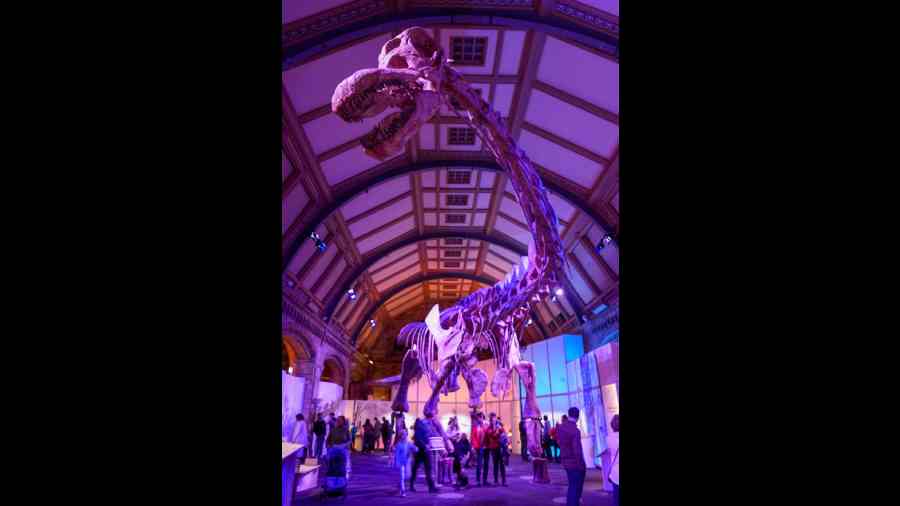Hefty history
I was given an 8.30 am slot to view the Natural History Museum’s newest celebrity, the Titanosaur, the largest animal to ever walk on earth. When the ground shook under its tread 101 million years ago, it was 37 metres long — 12 metres longer than a blue whale — weighed 57 tonnes and ate 129 kilogrammes of plant material every day. Viewed from behind, I felt I had stepped into a scene from Jurassic Park. The Titanosaur is so long that its tail poked out of the museum’s Waterhouse Gallery, whose foundations had to be strengthened to bear its weight. The femur is 4.4 metres long and weighs 500kg.
The Titanosaur, found in Patagonia, Argentina, in 2010, arrived in 32 crates in two airplanes and was assembled in London “like a giant jigsaw puzzle,” I was told by my guide, Sinead Marron, the museum’s exhibition and interpretation manager. “It’s obviously an incredible and awe-inspiring experience to stand underneath something so huge,” she said.
“What we wanted to do with this exhibition is look at some of the challenges of being a giant,” said Marron. “We’re looking at making those comparisons between awesome animals in the past, and the ones that we have today, and thinking about how we can help them. Today, we also have our own amazing and incredible giants — like elephants — that we need to protect.”
I don’t want to raise false hopes that Indians will have the thrill of seeing the Titanosaur one day. But the museum’s director of development, Jennifer Cormark, remarked: “Whatever relationship the Natural History Museum has with India, we want more.”
Rocking relics
Sotheby’s in London is hosting an auction that will rock the art world. It is going to sell 1,500 objects from the private collection of the Parsi boy, Farrokh Bulsara. He was born in Zanzibar in 1946, went to school in Bombay, came to England in 1964 and found fame as Freddie Mercury, the lead vocalist of the rock band, Queen, and died in 1991. Also part of the auction is a replica of the St Edward’s Crown which King Charles III will wear at his coronation.
Fill the gaps
Censorship was one of the recurring themes discussed at the London Book Fair last week. There was one session organised by English PEN, “one of the world’s oldest human rights organisations”. The session was chaired by Nicky Parker, “who heads Amnesty International’s literature and human rights programme”.
She thinks it is wrong to take out references to, say, the Gujarat riots or to marginalise the Mughal period in history books in India. She would consider it equally regressive if British history books removed discussions on whether Winston Church aggravated the Bengal Famine of 1943 or ordered the bombing of Dresden for reasons other than military during World War II.
“I would absolutely not condone or support that,” she said. “It’s censorship to eliminate or erase people’s presence in history. What you want is for people to find the facts for themselves and, if they feel uncomfortable about something, to read more widely. Truth is a very broad word, isn’t it, but [people should] really look at sources of information that are reputable, and not just believe one voice. The more understanding we have of the past, whether it’s our own family or wider society, the greater strength that gives us to go forward with a better awareness of justice and fairness and how to treat other people.”
Include the margins
Another session at the London Book Fair dealt with the question of whether it is right for publishers to replace words and phrases that a new generation of readers might find offensive or racist in, say, Enid Blyton, Agatha Christie, Ian Fleming, Roald Dahl and even PG Wodehouse. According to Hannah Gómez, senior editor at Kevin Anderson & Associates, “cultural accuracy editing, also known as sensitivity reading, is not, as some people mistakenly believe, an act of censorship, but a way to elevate literary quality and ensure inclusivity, which can lead to wider readership and greater sales”.
A third session, “Translation in Multilingual India”, was chaired by Kavita Bhanot from Birmingham — she has translated Anjali Kajal’s Ma is Scared from Hindi to English — and featured Nikhil Pandhi, Samvartha Sahil and Namrata Chaturvedi. Pandhi — “an Ambedkarite queer-feminist researcher and anti-caste literary translator from India” completing a PhD in cultural anthropology at Princeton University — is editing and translating Love in the Time of Caste, a collection of selected contemporary Dalit-feminist love stories, forthcoming from Zubaan, India’s leading feminist press.










